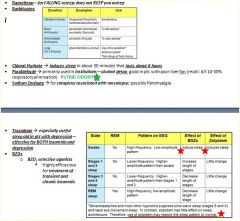![]()
![]()
![]()
Use LEFT and RIGHT arrow keys to navigate between flashcards;
Use UP and DOWN arrow keys to flip the card;
H to show hint;
A reads text to speech;
21 Cards in this Set
- Front
- Back
|
Other drugs:
What is the MOA of sodium oxylate? **EXAM** |
- Also known as gamma hydroxybutyrate (GHB)
- GHB is a breakdown product of GABA and functions as an endogenous neuromodulator with effects on vigilance and other behaviors - May stimulate GABAB and specific GHB receptors **Clinical Use** May also help sleep problems associated with fibromyalgia** - Recently approved by FDA to treat cataplexy** (sudden loss of motor tone) associated with narcolepsy • Thought to improve quality of nighttime sleep and thus decrease daytime sleepiness and cataplexy ***GHB is a drug of abuse and can produce both psychological and physical dependence*** |
|
|
Which class of drugs is most likely to precipitate acute intermittent porphyria in a genetically predisposed individual?
**EXAM** |
**Barbiturates**
- Chronic administration may result in enzyme induction (phenobarbital = classical inducer)** • Autoinduction – accounts for some drug tolerance - **Induction of other enzyme systems may precipitate acute intermittent porphyria** (contraindication)—some pts are genetically predisposed to this |
|
|
The following are drugs that are **sleep inducers**
These do not put you to sleep for more than 8 hrs!! **EXAM** |

|
|
|
This drug induces sleep (not for 8 hrs)
primarily used in institutions—alcohol detox - good in pts with poor liver fxn (recall: d/t 10-30% respiratory elimination) - **Putrid Odor** limits use |
Paraldehyde
|
|
|
This drug induces sleep (not for 8 hrs)
**Activates melatonin receptors MT1 and MT2** -MT1 regulates sleep -MT2 mediates phase shifting on circadian rhythm. ◦ Effects on sleep - decreases sleep latency (desired effect) - slight decreases in stage 3 & 4 - does not help to stay asleep (duration 2-4 hrs) - No tolerance, so ok for chronic use. ◦ For patients that have difficulty falling asleep |
Ramelteon
|
|
|
Unique side effect of Ramelteon?
|
Hyperprolactinemia
|
|
|
This drug induces sleep (not for 8 hrs)
-Metabolized by alcohol dehydrogenase to trichloroethanol (active form) - Effective sedative and hypnotic induces sleep in about 30 minutes that lasts about 6 hours **Knock-out drops** or **Mickey Finn** --> enhanced toxic effect when mixed with ethanol |
Chloral Hydrate
|
|
|
This drug induces sleep (not for 8 hrs)
- GHB is a breakdown product of GABA and functions as an endogenous neuromodulator with effects on vigilance and other behaviors - May stimulate GABAB and specific GHB receptors -for cataplexy associated with narcolepsy; possibly fibromyalgia *Side Effects* - Sleepwalking - Incontinence - Respiratory depression and amnesia (esp. combined with alcohol or other CNS depressants) |
• Sodium Oxybate
|
|
|
This drug induces sleep (not for 8 hrs)
-These two drugs are Barbituates used to help patients fall asleep -Used as hypnotics due to their intermediate duration of effects (4-6 hrs) |
Secobarbital and pentobarbital
|
|
|
What (2) barbituates are used for induction anesthesia because of their rapid brief effects?
|
Thiopental and hexibarbital
|
|
|
This barbituate drug has an intermediate action to help patients **stay asleep** (6-8hrs)
*** |
amobarbital
|
|
|
Name the drug class:
MOA: ◦ Like BDZs, enhance GABA effects ◦ act at a specific receptor site on the GABA receptor-modulated ionophore ◦ Keeps the Cl- channel open longer |
**Barbituates**
CNS effects: -sedation -hypnotic -REM Rebound (↓REM, ↑ duration of stage 2 NREM) -Hangover (worse with longer acting) -Paradoxical excitement (Wired!!) -Hyperalgesia (↑ Pain) - Anticonvulsant (Phenobarb only) |
|
|
This drug induces sleep (not for 8 hrs)
- especially useful sleep aid in pts with depression—effective for BOTH insomnia and depression** -Atypical antidepressant with pronounced sedative properties -Unlike many antidepressants that are likely to cause insomnia, even when taken in the morning - can be used to treat insomnia caused by other antidepressant medications *** |
Trazodone
|
|
|
This drug induces sleep (no more than 8 hr)
Mechanism – chemically not benzodiazepines but bind to a subtype (BZD1) **Pharmacological effects** - activation of the BZD1 receptor results in hypnosis but not anticonvulsant or muscle relaxing effects - produce minimal rebound insomnia or disruption of deep sleep - Highly efficacious for treatment of transient and chronic insomnia **EXAM** |
Zolpidem, zaleplon and eszopiclone
**may return sleep pattern to normal** |
|
|
Name the drug class:
- bind to both BDZ1 and BDZ2 ◦ BDZ1 has minimal effect on sleep architecture ◦ BDZ2 may change sleep patterns - Hypnotics used most frequently today selectively bind to BDZ1***** - They also have a shorter duration givine less daytime sedation and hangover |
Benzodiazpepines (BDZ)
|
|
|
Most BDZ hypnotics bind to (BDZ1 or BDZ2)
|
BDZ1 receptors
|
|
|
What is the antidote for BDZ overdose?
***EXAM*** |
**Flumazenil**
**BDZ specific** receptor antagonist **Used to counteract adverse effects of BDZ ** - Rapid onset and short duration - May precipitate seizures, arrhythmias, emotional lability - Often used to take pts more quickly out of anesthesia |
|
|
What is a good way to help get Phenobarbital out of the system of someone who has overdosed?
|
Phenobarb has RENAL EXCRETION
You can alkalinize the urine!!! |
|
|
how is 10-30% of paraldehyde excreted?
|
Respiratory!
|
|
|
Which BZDs produce no active metabolites
**Use in Elderly with Liver Problems** |
Temazepam
Estazolam (bitter aftertaste!) Lorazepam Oxazepam **TELO** |
|
|
BZDs and MOST OTHER hypnotic agents SUPPRESS slow-wave sleep (Stages 3 and 4) and REM sleep
Which of the hypnotic agents appears to disturb sleep patterns the least? |
Zolpidem (4hr)
Zaleplon (6-8hr) Eszopiclone (8hr) (BZD1 agonists) |

